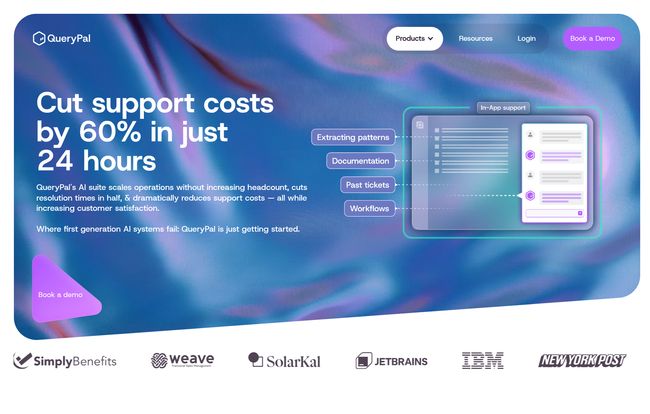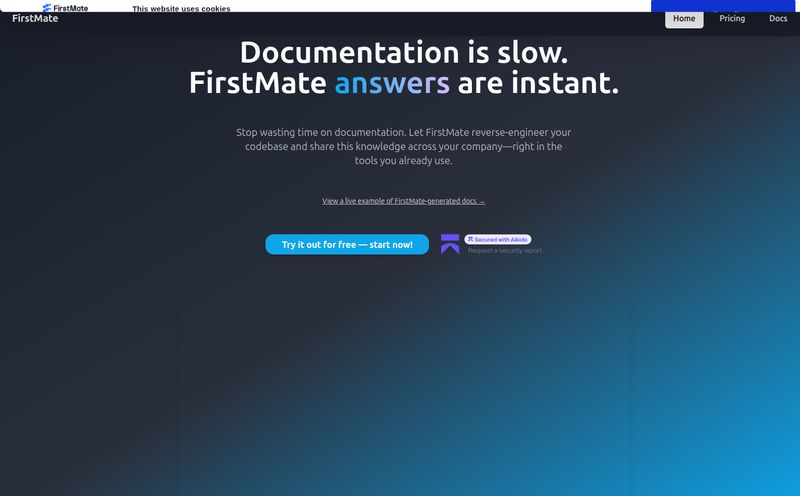If you're in the support game, you know the feeling. The ticket queue is a monster that never sleeps. You close five, ten more appear. Your team is burning out answering the same questions over and over, and your beautifully curated knowledge base? It’s mostly gathering digital dust. We've all been there, dreaming of a magic wand to make it all go away.
For years, the promise of AI in customer support has felt… well, a little hollow. We were sold clunky chatbots that frustrated customers more than they helped. But the tech is getting smarter. Scarily smarter. And lately, a tool called QueryPal has been making some serious noise, claiming to cut support costs by 20% in just 24 hours.
A bold claim. As someone who’s seen a lot of tools come and go, my skepticism meter was twitching. But with names like IBM and JetBrains using them, I had to take a closer look. Is this another overhyped bot, or is it the real deal?
What Exactly Is QueryPal? (And Why Should You Care?)
So what is this thing? At its core, QueryPal is an AI chat assistant designed to live inside the tools your team already uses every single day: Slack and Microsoft Teams. It’s not another dashboard you have to keep open in a new tab. This, for me, is already a massive win. Adoption is everything.
Think of it like this: You’ve hired a brilliant junior support agent. This agent has read every single page of your Confluence, every Google Doc, every Notion page, and every closed Jira ticket. They've memorized your entire company brain. Now, they sit in your company's main chat, ready to instantly answer questions from both your staff and, if you set it up, your customers.
That's QueryPal. It plugs directly into your existing data sources and uses that information to deflect support requests before they ever become a formal ticket. It’s not just about automating responses; it’s about making your entire library of institutional knowledge accessible and interactive.

Visit QueryPal
The Features That Made Me Look Twice
A flashy homepage is one thing, but the feature set is where the rubber meets the road. And QueryPal has a few things that genuinely caught my attention, moving it from the 'yet another AI tool' category into 'hmm, this could actually work'.
Intelligent Ticket Deflection isn't Just a Buzzword
They claim to deflect 50% of tickets. How? By providing instant, accurate answers from your own documentation. A customer has a question. Instead of emailing support, they ask the QueryPal bot. The bot gives them the answer, citing the source document. The customer is happy, no ticket is created, and your support agent can focus on a more complex issue. This isn’t about tricking users with a frustrating chatbot loop; it’s about providing genuine self-service that works.
Living Where Your Team Lives: Slack and Teams Integration
I can't stress this enough. The biggest barrier to new software is getting people to use it. By integrating directly into Slack and Teams, QueryPal removes that friction. Your internal teams can ask questions— “what’s our policy on X?” or “how do I process a Y?” — without leaving the chat they already have open. It becomes part of the natural workflow, not an interruption to it.
AI Ticket Drafts and Continuous Learning
Okay, so what happens when a ticket does get through? This is the cool part. QueryPal doesn't just give up. It drafts a response for your agent based on all that knowledge it has. The agent can then review, edit, and send it. But here’s the kicker: the AI learns from those edits. This “Continuous AI Growth” via agent feedback means the system gets progressively smarter and more accurate over time. Your own team's expertise actively trains the AI. It's a symbiotic relationship, not a replacement.
Global Support with Multi-Language Capabilities
For any company with a global footprint, this is a game-changer. The ability to understand and respond in multiple languages without needing a massive, multilingual support team is a huge operational advantage. It democratizes support for your entire user base.
The Good, The Bad, and The Pricey
No tool is perfect, and a real review needs to look at the whole picture. I was genuinely impressed by a lot, but there are some definite things to consider.
The Good Stuff (Why I'm Genuinely Impressed)
The first thing that stood out is the potential to genuinely reduce agent workload and burnout. That’s not just a cost-saving measure; it’s a culture-saving one. Happy agents lead to happy customers. The transparency is another big plus. The “AI Decision Visibility” feature lets you see why the AI gave a certain answer and which document it came from. This builds trust, a rare commodity in the world of black-box AI tools. And for the corporate folks, the fact that it's SOC 2 & GDPR Compliant is non-negotiable. Security clearly isn't an afterthought here, which is a relief.
The Not-So-Good Stuff (The Reality Check)
Okay, but it's not all sunshine and rainbows. First, the old mantra holds true: garbage in, garbage out. QueryPal's effectiveness is directly tied to the quality of your existing documentation. If your knowledge base is a chaotic mess of outdated articles, the AI will just serve up that chaos with confidence. It forces you to get your house in order, which is a good thing, but it's work you have to do.
And then there's the pricing. This might be the biggest hurdle for many.
So, How Much Does QueryPal Cost?
This is where things get a bit opaque. QueryPal doesn't list public prices. They use a custom pricing model, which is common for enterprise-focused SaaS but can be frustrating for smaller businesses trying to budget. You have to book a demo to get a quote. Here's what we know from their pricing page:
| Plan | Ticket Volume | Best For |
|---|---|---|
| Pro | Up to 5,000 tickets/month | Teams looking to get started quickly with AI-drafted email support directly in their helpdesk. |
| Enterprise | 5,000+ tickets/month | Larger organizations needing secure, customizable AI support across multiple channels. |
My take? The custom pricing signals that they're targeting established companies with significant support volume where the ROI of a 20% cost reduction is a very, very big number. If you're an early-stage startup, this might not be the most accessible option.
Who is QueryPal Actually For?
After digging in, a clear picture emerges. QueryPal seems like a perfect fit for a specific type of company.
It’s probably for you if:
- You're a mid-to-enterprise level company with high support ticket volume.
- Your team lives and breathes in Slack or Microsoft Teams.
- You have a well-maintained (or are willing to maintain) knowledge base in tools like Confluence, Notion, or Google Drive.
- Security and compliance (SOC 2, GDPR) are top priorities.
It’s probably not for you if:
- You're a very small startup with low ticket volume.
- Your documentation is non-existent or a complete disaster.
- You're on a shoestring budget and need transparent, fixed monthly pricing.
The Final Verdict
So, is QueryPal the ticket deflection hero we've been waiting for? For the right company, I think the answer is a resounding yes. It’s not just another chatbot. It’s an intelligent, integrated layer that makes your entire organization's knowledge useful, reduces repetitive work, and empowers both your customers and your support team.
It’s not a magic wand—you still need quality documentation. And the custom pricing will be a barrier for some. But if your team is drowning in repetitive tickets and you're ready to invest in a solution that works with your team instead of replacing them, QueryPal is absolutely worth a demo. It might just be the lifeline you need.
Frequently Asked Questions about QueryPal
Does QueryPal replace my human support agents?
No, and that's one of its strengths. QueryPal is designed to augment your existing team, not replace them. It handles the repetitive, easy-to-answer questions, freeing up your human agents to focus on complex, high-value customer issues that require a human touch.
What tools does QueryPal integrate with?
It integrates with the places you work and store knowledge. For chat, that’s Slack and Microsoft Teams. For knowledge sources, it connects to a wide array including Google Drive, Notion, Jira, Confluence, Zendesk, and Intercom, among others.
Is QueryPal secure for enterprise use?
Yes. It is SOC 2 and GDPR compliant, which are critical security and privacy standards. This shows a strong commitment to enterprise-grade security, making it a viable option for companies that handle sensitive data.
How does QueryPal learn and improve?
It uses a continuous learning loop. When the AI drafts a response for a ticket, your support agent can approve or edit it. The AI learns from these human corrections, constantly improving its accuracy and tone to better match your company's voice.
Can I get QueryPal if my company is small?
While their pricing model is custom and geared towards larger teams, it might depend on your specific needs. The "Pro" plan is for teams with up to 5,000 tickets per month. If you fall below that but still see value, your best bet is to contact their sales team for a conversation. They can provide a specific quote based on your situation.



